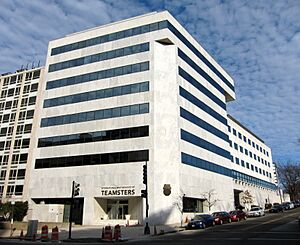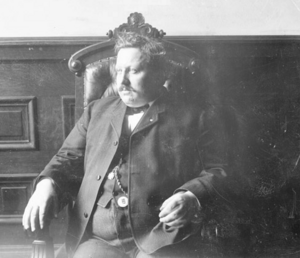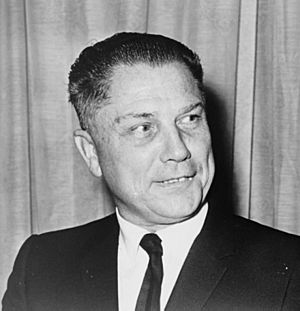International Brotherhood of Teamsters facts for kids
 |
|
| Abbreviation | IBT |
|---|---|
| Formation | 1903 |
| Merger of |
|
| Type | Trade union |
| Headquarters | Washington, D.C., U.S. |
| Location |
|
|
Membership (2015)
|
1.3 million |
|
General president
|
Sean M. O'Brien |
|
Secretary-treasurer
|
Fred Zuckerman |
| Affiliations |
|
|
Formerly called
|
International Brotherhood of Teamsters, Chauffeurs, Warehousemen and Helpers of America |
The International Brotherhood of Teamsters (IBT) is a large labor union in the United States and Canada. A labor union is an organization of workers who join together to get better pay, benefits, and working conditions.
The Teamsters union was formed in 1903 when two smaller unions for truck drivers decided to merge. Today, the union represents all kinds of workers, from warehouse employees and drivers to office workers and government staff. In 2015, it had about 1.3 million members.
Contents
History of the Teamsters
The Teamsters union has a long and interesting history, with periods of great growth and serious challenges.
How the Union Began
In the late 1800s, the American Federation of Labor (AFL), a large group of unions, helped horse-drawn wagon drivers, called "teamsters," form local unions. By 1903, two main teamster unions joined together to create the International Brotherhood of Teamsters. Cornelius Shea was elected as its first president.
In its early days, the union was made up of many local groups that often acted on their own. Teamsters were very important because they could stop the movement of goods in a city by going on strike. This power sometimes led to problems, and the union's early years were marked by major strikes and leadership struggles.
One of the biggest events was the 1905 Chicago teamsters' strike, which involved over 25,000 workers. However, public support for the strike faded, and it ended without success. After facing several challenges, Shea was replaced by Daniel J. Tobin in 1907.
Growth and New Leadership
Daniel J. Tobin led the Teamsters for 45 years, from 1907 to 1952. Under his leadership, the union became much more organized and powerful. He created "joint councils" to connect local unions and encouraged leaders to negotiate contracts that covered many employers at once.
The union grew quickly during the Great Depression of the 1930s. Many workers wanted to join unions to protect their jobs. By 1941, the Teamsters had over 500,000 members, making it one of the fastest-growing unions in the country.
A famous event happened in 1934 during the Minneapolis Teamsters Strike. A local union in Minneapolis organized a successful strike that showed the growing power of the Teamsters. This helped the union organize thousands more truckers across the Midwest.
During World War II, the Teamsters supported the country's war effort. President Franklin D. Roosevelt even appointed Tobin as a special advisor on labor issues. By the end of the war, the Teamsters had become one of the most powerful unions in the United States.
Challenges and Investigations
After Tobin retired in 1952, Dave Beck became president. During this time, the union faced serious accusations of corruption and influence from criminal groups. These problems drew the attention of the U.S. government.
In the mid-1950s, the U.S. Senate formed a special committee, led by Senator John L. McClellan, to investigate problems in labor unions. The committee's chief lawyer was Robert F. Kennedy, who later became Attorney General. The hearings were broadcast on television and revealed major issues within the Teamsters.
As a result of the investigation, Dave Beck was forced to step down. In 1957, Jimmy Hoffa was elected as the new president. Because of the ongoing problems, the AFL–CIO (the main federation of American unions) voted to expel the Teamsters in 1957. The Teamsters would not rejoin the AFL-CIO for nearly 30 years.
The Jimmy Hoffa Era
Jimmy Hoffa was a powerful and controversial leader. His biggest achievement was creating the National Master Freight Agreement in 1964. This was a single contract for nearly all truck drivers in the country, and it brought them much better wages and benefits. For many, this was a golden age for truckers.
However, Hoffa also faced continued legal battles with the government. In 1967, he was sent to prison. He chose Frank Fitzsimmons to lead the union while he was away.
In 1975, after being released from prison, Jimmy Hoffa disappeared. He was last seen in a restaurant parking lot in Michigan. His disappearance has never been solved, and he is presumed to be dead.
Changes and New Challenges
Under Frank Fitzsimmons, the union's power shifted back to regional and local leaders. The 1970s also saw the Teamsters merge with the Brewery Workers union.
A major challenge came in the late 1970s when the U.S. government deregulated the trucking industry. This meant there were fewer rules, and new non-union companies entered the market. This created a lot of competition, and many unionized trucking companies went out of business. Thousands of Teamsters lost their jobs.
During this time, reform groups like Teamsters for a Democratic Union (TDU) began to form. These groups wanted to give members more say in the union's decisions and fight against corruption.
In the late 1980s, the U.S. government filed a lawsuit against the Teamsters to fight corruption. To settle the case, the union agreed to allow the government to oversee its operations. This led to a major change: for the first time, members could directly vote for their international president.
The Modern Teamsters

In 1991, Ron Carey, a reform candidate supported by the TDU, won the first direct election for president. In 1997, his administration led a successful strike against UPS, which was a major victory for the union.
However, Carey was later removed from office due to issues with his campaign funding. In 1998, James P. Hoffa, the son of Jimmy Hoffa, was elected president. He led the union for over 20 years.
In 2005, the Teamsters left the AFL-CIO again to help form a new group of unions called the Change to Win Federation.
In 2021, Sean O'Brien was elected president, running on a platform of taking a stronger stance in negotiations. His election marked a major change in leadership for the union.
What Do the Teamsters Do Today?
Today, the Teamsters union represents workers in many different industries, not just trucking. These include:
- Airline pilots and mechanics
- Warehouse workers
- Public employees, like police officers and firefighters
- Food processing workers
- Railroad workers
- Workers in the movie industry
The union is very active in politics. It supports laws and politicians that it believes will help working people. The Teamsters union is one of the largest and most influential labor unions in North America.
Images for kids
See also
- Teamsters Canada





